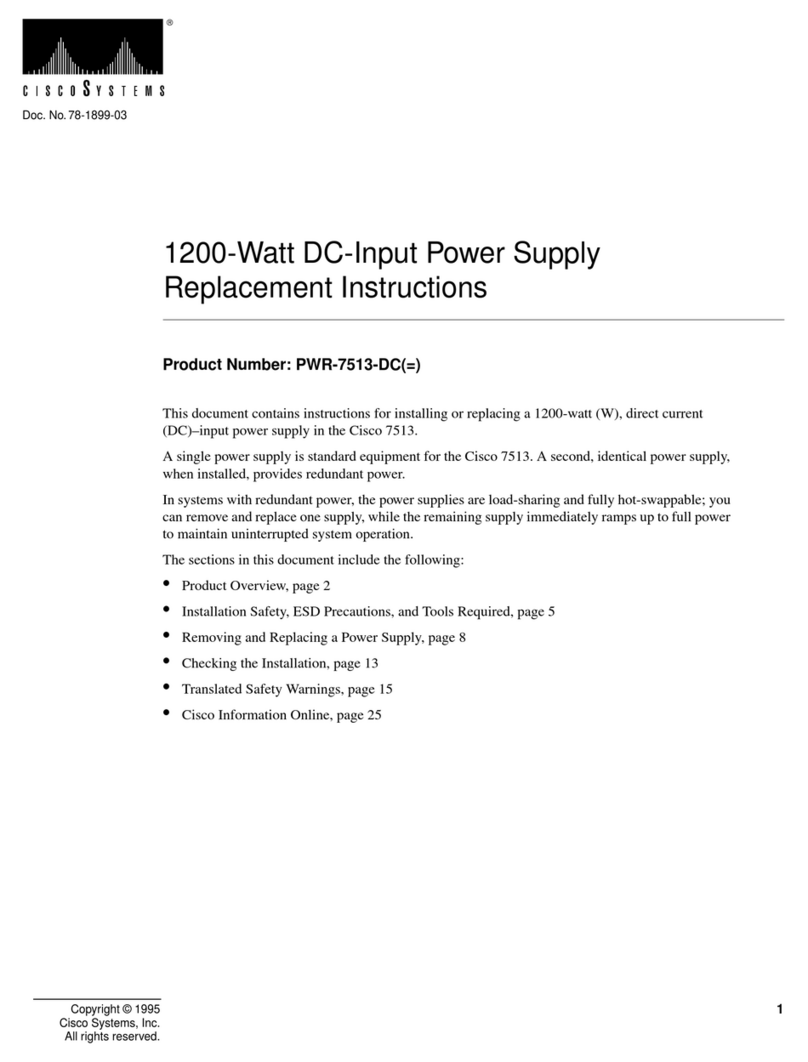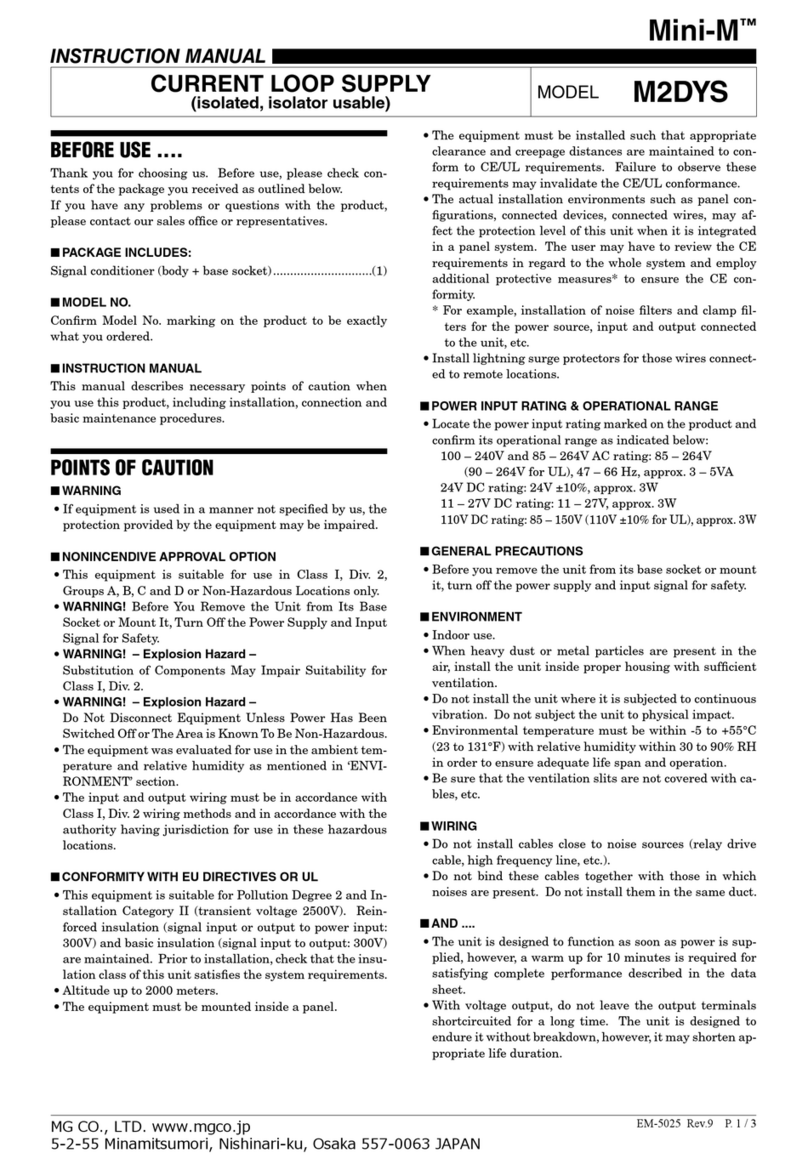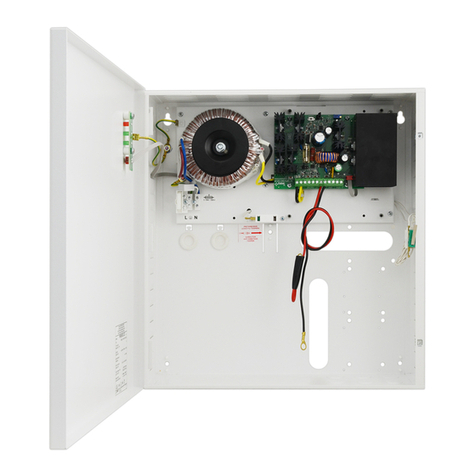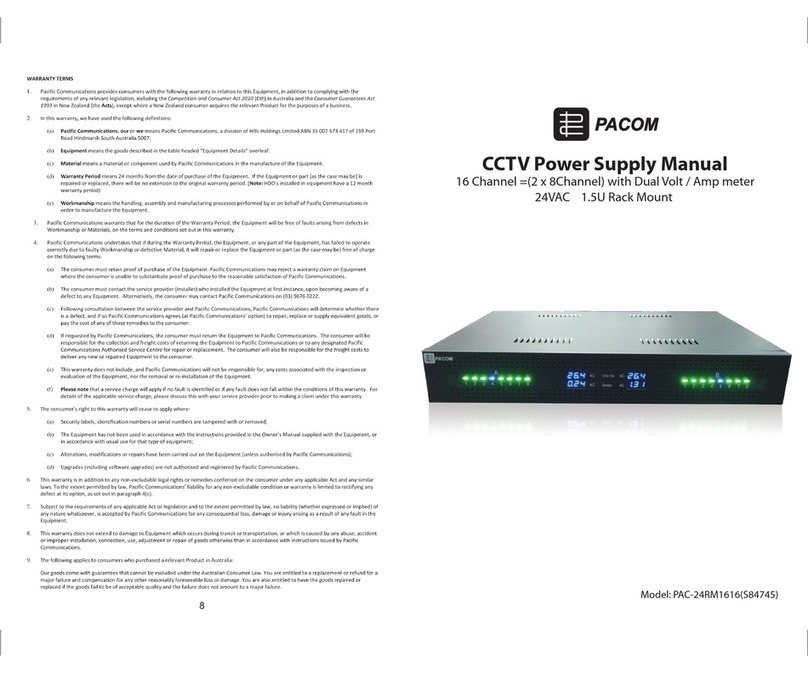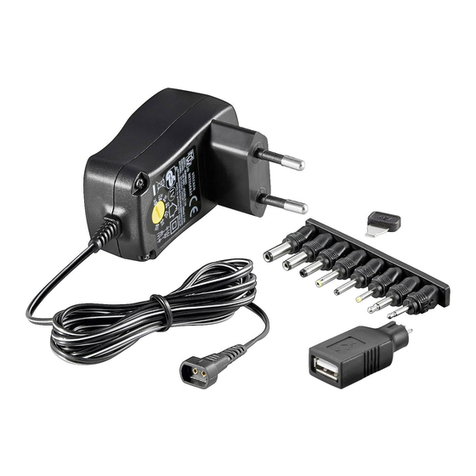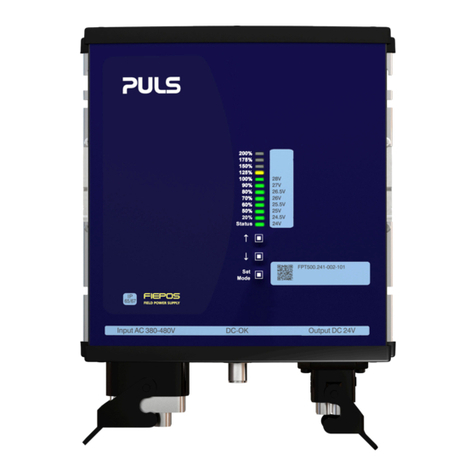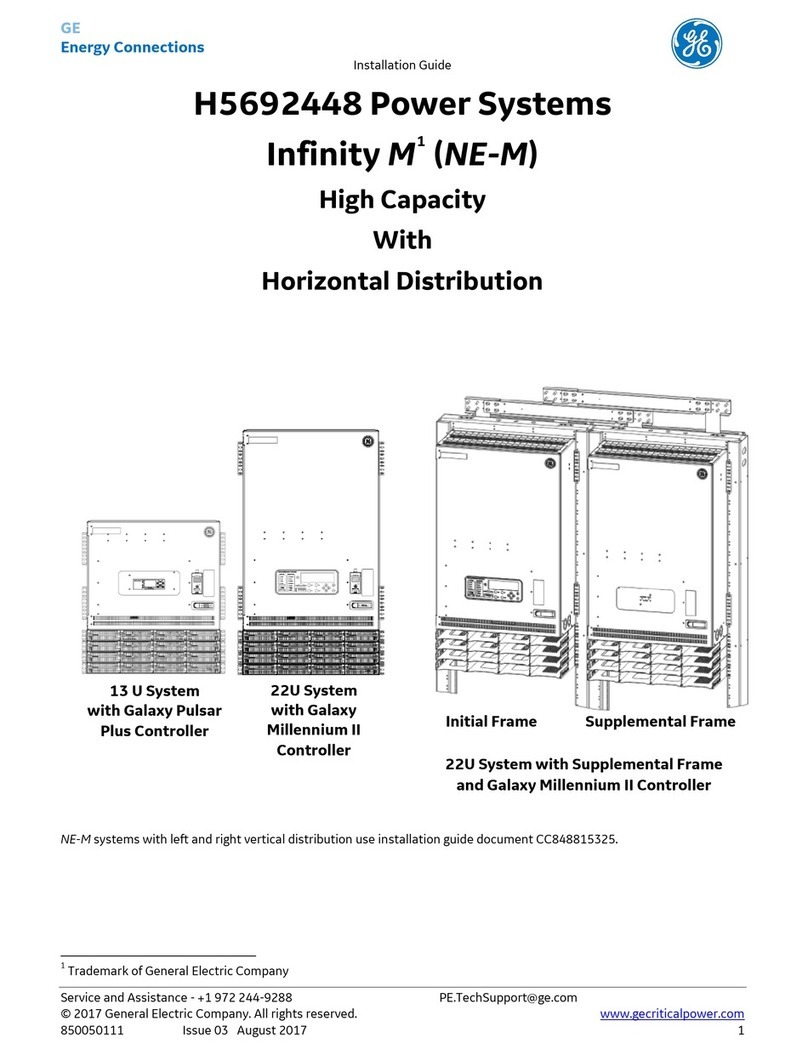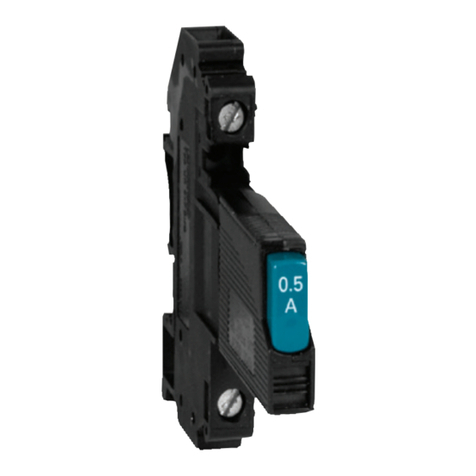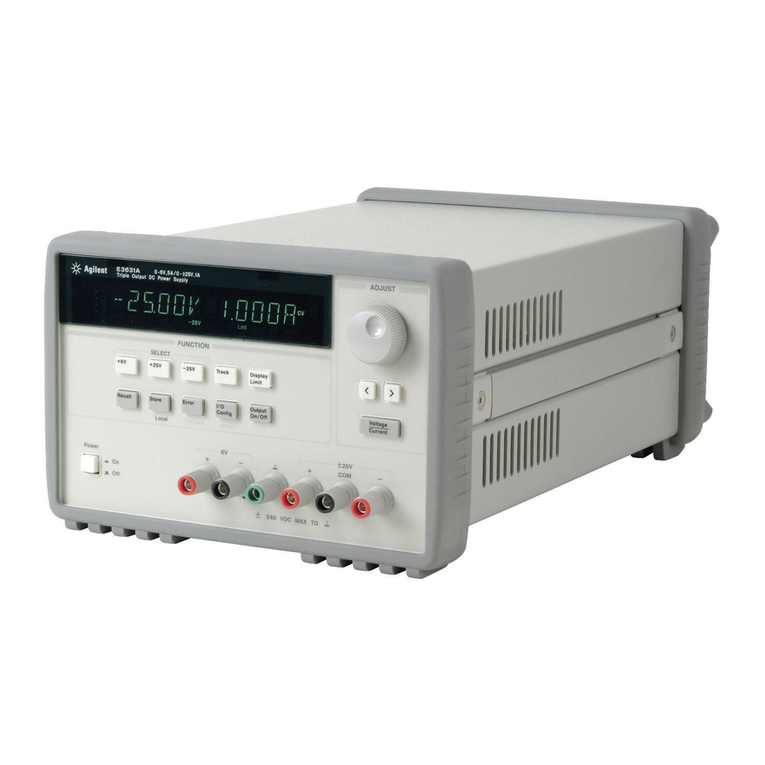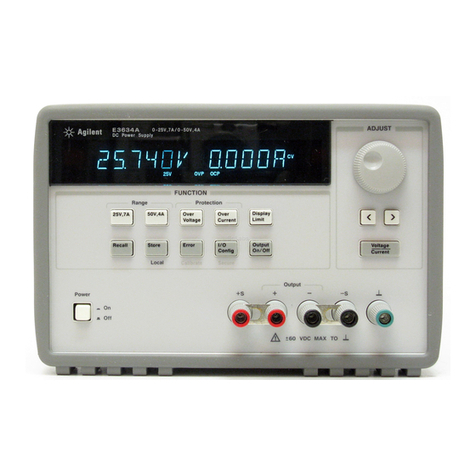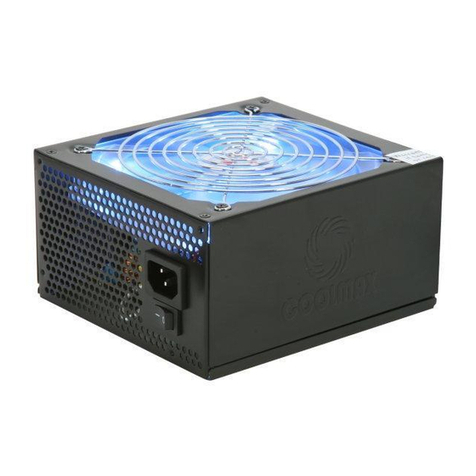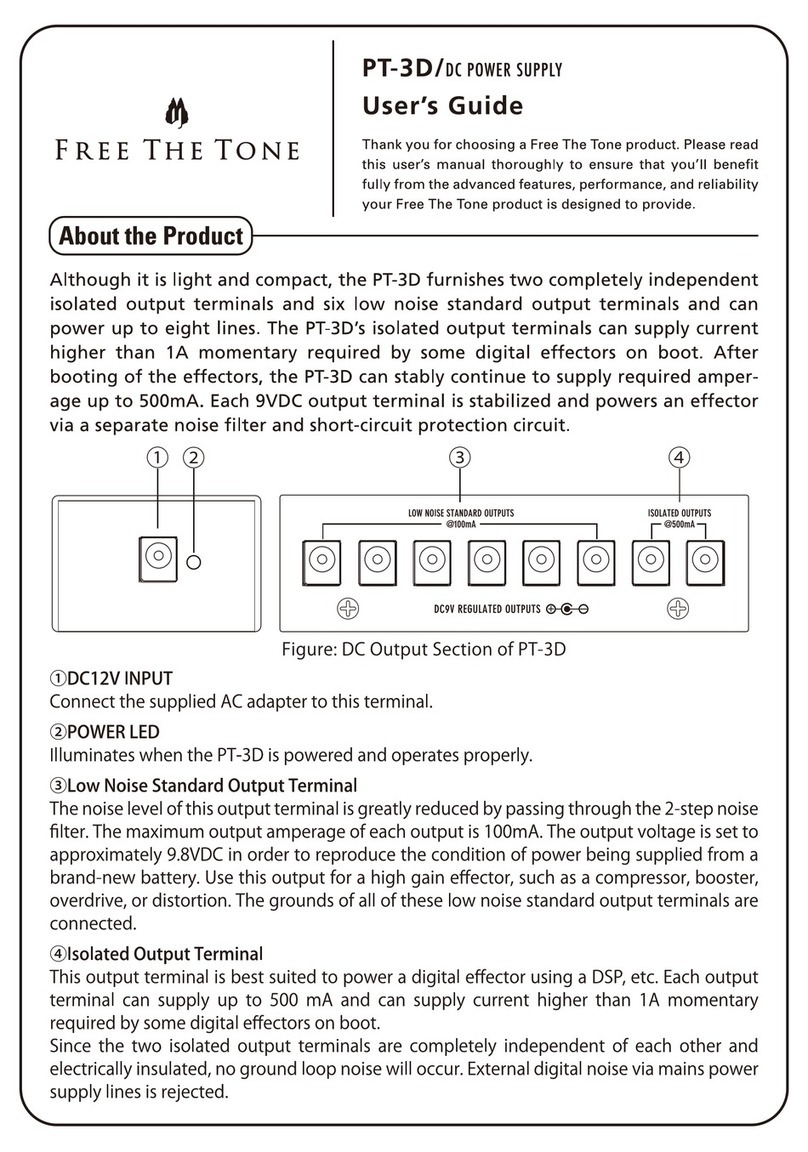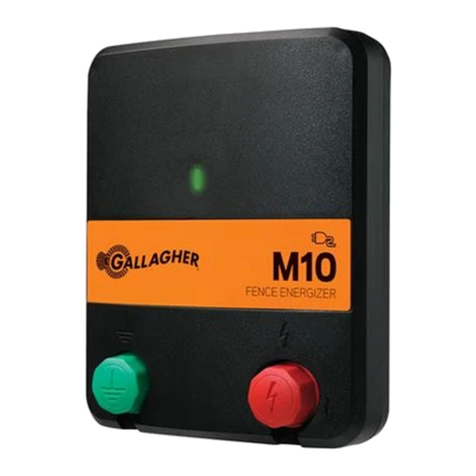MGE UPS Systems EPS 7000 User manual

EPS 7000
Single Module
Users Manual
www.mgeups.com

IMPORTANT SAFETY INSTRUCTIONS
SAVE THESE INSTRUCTIONS – This manual contains important instructions for all EPS 7000 Single Module that
must be followed during operation of the equipment.
WARNING: Opening enclosures expose hazardous voltages. Always refer
service to qualified personnel only.
ATTENTION: L'ouverture des cabinets expose des tensions dangereuses.
Assurez-vous toujours que le service ne soit fait que par des
personnes qualifiees.
WARNUNG! Das öffnen der Gehäuse legen gefährliche Spannungen bloss.
Service sollte immer nur von qualifizierten Personal durchgeführt
werden.
WARNING: As standards, specifications, and designs are subject to change,
please ask for confirmation of the information given in this
publication.
ATTENTION: Comme les normes, spécifications et produits peuvent changer,
veuillez demander confirmation des informations contenues dans
cette publication.
WARNUNG! Normen, Spezifizierungen und Pläne unterliegen Anderungen.
Bitte verlangen Sie eine Bestätigung über alle Informationen, die in
dieser Ausgabe gemacht wurden.
NOTE: This equipment generates, uses, and can radiate radio
frequency energy and, if not installed and used in accordance
with installation manual, may cause harmful interference to
radio communications. Operation of this equipment in a
residential area is likely to cause harmful interference in which
case the user will be required to correct the interference at his
own expense.
Important Safety information
EPS 7000 Single Module
page ii

EPS 7000
Single Module
Users Manual
For service call
1-800-523-0142
86-134004-00 X0 08/04
Copyright © 2004 MGE UPS SYSTEMS, Inc.
All rights reserved. Printed in U.S.A.
MGE UPS SYSTEMS, Inc.
1660 Scenic Avenue
Costa Mesa, CA 92626
(714) 557-1636
page iii
Users Manual

EPS 7000 Single Module
page iv
EPS 7000
Single Module Users Manual
Warranty Information
Warranty
The liability of MGE UPS SYSTEMS, Inc. hereunder is limited to replacing or repairing at MGE UPS
SYSTEMS, Inc.’s factory or on the job site at MGE UPS SYSTEMS, Inc.’s option, any part or parts which are
defective, including labor, for a period of 12 months from the date of purchase. The MGE UPS SYSTEMS, Inc.
shall have the sole right to determine if the parts are to be repaired at the job site or whether they are to be
returned to the factory for repair or replacement. All items returned to MGE UPS SYSTEMS, Inc. for repair or
replacement must be sent freight prepaid to its factory. Purchaser must obtain MGE UPS SYSTEMS, Inc.’s
Return Materials Authorization prior to returning items. The above conditions must be met if warranty is to be
valid. MGE UPS SYSTEMS, Inc. will not be liable for any damage done by unauthorized repair work, unautho-
rized replacement parts, from any misapplication of the item, or for damage due to accident, abuse, or Act of
God.
In no event shall the MGE UPS SYSTEMS, Inc. be liable for loss, damage, or expense directly or indirectly
arising from the use of the units, or from any other cause, except as expressly stated in this warranty. MGE
UPS SYSTEMS, Inc. makes no warranties, express or implied, including any warranty as to merchantability or
fitness for a particular purpose or use. MGE UPS SYSTEMS, Inc. is not liable for and Purchaser waives any
right of action it has or may have against MGE UPS SYSTEMS, Inc. for any consequential or special damages
arising out of any breach of warranty, and for any damages Purchaser may claim for damage to any property or
injury or death to any person arising out of its purchase of the use, operation or maintenance of the product.
MGE UPS SYSTEMS, Inc. will not be liable for any labor subcontracted or performed by Purchaser for
preparation of warranted item for return to MGE UPS SYSTEMS, Inc.’s factory or for preparation work for field
repair or replacement. Invoicing of MGE UPS SYSTEMS, Inc. for labor either performed or subcontracted by
Purchaser will not be considered as a liability by the MGE UPS SYSTEMS, Inc.
This warranty shall be exclusive of any and all other warranties express or implied and may be modified
only by a writing signed by an officer of the MGE UPS SYSTEMS, Inc. This warranty shall extend to the
Purchaser but to no one else. Accessories supplied by MGE UPS SYSTEMS, Inc., but manufactured by others,
carry any warranty the manufacturers have made to MGE UPS SYSTEMS, Inc. and which can be passed on to
Purchaser.
MGE UPS SYSTEMS, Inc. makes no warranty with respect to whether the products sold hereunder
infringe any patent, U.S. or foreign, and Purchaser represents that any specially ordered products do not
infringe any patent. Purchaser agrees to indemnify and hold MGE UPS SYSTEMS, Inc. harmless from any
liability by virtue of any patent claims where Purchaser has ordered a product conforming to Purchaser’s speci-
fications, or conforming to Purchaser’s specific design.
Purchaser has not relied and shall not rely on any oral representation regarding the Product sold
hereunder and any oral representation shall not bind MGE UPS SYSTEMS, Inc. and shall not be part of any
warranty.
There are no warranties which extend beyond the description on the face hereof. In no event shall MGE
UPS SYSTEMS, Inc. be responsible for consequential damages or for any damages except as expressly stated
herein.
Service and Factory Repair - Call
1-800-523-0142
Direct questions about the operation, repair, or servicing of this equipment to MGE UPS SYSTEMS, Inc.
Technical Support Services. Include the part number and serial number of the unit in any correspondence.
Should you require factory service for your equipment, contact MGE UPS SYSTEMS, Inc. Technical Support
Services and obtain a Return Materials Authorization (RMA) prior to shipping your unit. Never ship equipment
to MGE UPS SYSTEMS, Inc. without first obtaining an RMA.
Proprietary Rights Statement
The information in this manual is the property of MGE UPS SYSTEMS, Inc., and represents a proprietary
article in which MGE UPS SYSTEMS, Inc., retains any and all patent rights, including exclusive rights of use
and/or manufacture and/or sale. Possession of this information does not convey any permission to reproduce,
print, or manufacture the article or articles shown herein. Such permission may be granted only by specific
written authorization, signed by an officer of MGE UPS SYSTEMS, Inc.
IBM, PC-AT, ES/9000, and AS/400 are trademarks of International Business Machines Corporation. MGE
and MGE UPS SYSTEMS are trademarks of MGE UPS SYSTEMS, Inc. Other trademarks that may be used
herein are owned by their respective companies and are referred to in an editorial fashion only.
Revision History
EPS 7000 Single Module Users Manual
86-134004-00
Copyright © 2003 MGE UPS SYSTEMS, Inc. All rights reserved Printed in U.S.A.
Revision: X0 R&D-001651 08/2004

How To Use This Manual page v
Users Manual
How To Use This Manual
This manual is designed for ease of use and easy location of information.
To quickly find the meaning of terms used within the text, look to the Glossary.
To quickly find a specific topic, look at the Table of Contents.
This manual uses Note lines and icons to convey important information.
Note lines and icons come in four variations.
WARNING: Indicates information provided to protect the User and
service personnel against safety hazards and possible
equipment damage.
CAUTION: Indicates information provided to protect the User and
service personnel against possible equipment damage.
NOTE: Indicates information provided as an operating tip or an
equipment feature.
IMPORTANT: Indicates information provided as an operating instruction
or as a tip.

CAUTION
RECORD ALL SERIAL NUMBERS FOR THE SINGLE
MODULE UPS SYSTEM.
THESE SERIAL NUMBERS WILL BE REQUIRED IF
YOUR SYSTEM NEEDS SERVICE. KEEP THIS
MANUAL IN A PLACE WHERE YOU CAN REFERENCE
THE SERIAL NUMBERS IF SERVICE IS REQUIRED!
UPS UNIT SERIAL NUMBER: _____________________________________________
MBP CABINET SERIAL NUMBER: ________________________________________
ADDITIONAL SERIAL NUMBERS:
__________________________ ______________________________
__________________________ ______________________________
__________________________ ______________________________
__________________________ ______________________________
__________________________ ______________________________
__________________________ ______________________________
__________________________ ______________________________
__________________________ ______________________________
__________________________ ______________________________
__________________________ ______________________________
CAUTION: Record All Serial Numbers
EPS 7000 Single Module
page vi

page c i
Users Manual
Contents
section description . . . . . . . . . . . . . . . . . . . . . . . . . . . . . . . . . . . . . . . . .page
Important Safety Instructions . . . . . . . . . . . . . . . . .Inside Front Cover
Warranty . . . . . . . . . . . . . . . . . . . . . . . . . . . . . . . . . . . . . . . . . . . . .ivi
Revision History . . . . . . . . . . . . . . . . . . . . . . . . . . . . . . . . . . . . . . . .iv
How To Use This Manual . . . . . . . . . . . . . . . . . . . . . . . . . . . . . . . . .v
CAUTION: Record All Serial Numbers . . . . . . . . . . . . . . . . . . . . .vi
Table of Contents . . . . . . . . . . . . . . . . . . . . . . . . . . . . . . . . . . . . . .c-i
Section 1 Introduction
section description . . . . . . . . . . . . . . . . . . . . . . . . . . . . . . . . . . . . . .page
1.0 Scope . . . . . . . . . . . . . . . . . . . . . . . . . . . . . . . . . . . . . . . . . . .1-1
1.1 Reference Manuals . . . . . . . . . . . . . . . . . . . . . . . . . . . . . . . .1-1
1.2 Section Descriptions . . . . . . . . . . . . . . . . . . . . . . . . . . . . . . . .1-1
1.3 General Description . . . . . . . . . . . . . . . . . . . . . . . . . . . . . . . . .1-2
1.4 Specifications, Circuit Breakers and Powerflow Diagrams . . . .1-3
1.4.1 Circuit Breakers . . . . . . . . . . . . . . . . . . . . . . . . . . . . . . . . . . . .1-3
1.4.2 Power Flow Diagrams . . . . . . . . . . . . . . . . . . . . . . . . . . . . . . .1-5
1.4.2.1 Normal Operation . . . . . . . . . . . . . . . . . . . . . . . .1-5
1.4.2.2 On-Battery Operation . . . . . . . . . . . . . . . . . . . . . .1-5
1.5 Single Module Indicators and Controls . . . . . . . . . . . . . . . . . .1-6
1.5.1 Front Panel . . . . . . . . . . . . . . . . . . . . . . . . . . . . . . . . . . . . . . .1-7
1.5.2 Alphanumeric Display and Controls . . . . . . . . . . . . . . . . . . . . .1-8
1.5.2.1 Two-line Alphanumeric Display . . . . . . . . . . . . . .1-8
1.5.2.2 Alphanumeric Display Pushbuttons Descriptions .1-9
1.5.2.3 Numbered Lights . . . . . . . . . . . . . . . . . . . . . . . .1-10
1.5.3 Hidden Panel Indicators . . . . . . . . . . . . . . . . . . . . . . . . . . . . .1-10
1.5.3.1 LED Alphanumeric Indicator . . . . . . . . . . . . . . .1-11
1.5.3.2 Hidden Panel Lower Pushbuttons . . . . . . . . . . .1-12
Content

Section 2 Operation
section description . . . . . . . . . . . . . . . . . . . . . . . . . . . . . . . . . . . . . .page
2.0 Scope . . . . . . . . . . . . . . . . . . . . . . . . . . . . . . . . . . . . . . . . . . .2-1
2.1 Status Screen Display . . . . . . . . . . . . . . . . . . . . . . . . . . . . . . .2-1
2.2 Settings Selection Screen . . . . . . . . . . . . . . . . . . . . . . . . . . . .2-2
2.3 Alarms . . . . . . . . . . . . . . . . . . . . . . . . . . . . . . . . . . . . . . . . . . .2-2
2.4 Sensor Measurements . . . . . . . . . . . . . . . . . . . . . . . . . . . . . . .2-3
2.5 Voltage Measurements . . . . . . . . . . . . . . . . . . . . . . . . . . . . . .2-4
2.6 Current Measurements . . . . . . . . . . . . . . . . . . . . . . . . . . . . . .2-5
2.7 Power Frequency Measurements . . . . . . . . . . . . . . . . . . . . . .2-6
2.8 Battery Measurements . . . . . . . . . . . . . . . . . . . . . . . . . . . . . . .2-7
2.9 LCD Messages . . . . . . . . . . . . . . . . . . . . . . . . . . . . . . . . . . . .2-8
2.9.1 General Alarms . . . . . . . . . . . . . . . . . . . . . . . . . . . . . . . . . . . .2-8
2.9.2 Secondary Alarms . . . . . . . . . . . . . . . . . . . . . . . . . . . . . . . . . .2-8
2.10 Preparations Before Start-up . . . . . . . . . . . . . . . . . . . . . . . . .2-12
2.10.1 Checks Before Start-up . . . . . . . . . . . . . . . . . . . . . . . . . . . . .2-12
2.10.2 Start-up . . . . . . . . . . . . . . . . . . . . . . . . . . . . . . . . . . . . . . . . .2-12
2.10.3 Checks After Start-up . . . . . . . . . . . . . . . . . . . . . . . . . . . . . . .2-13
2.11 Shutdown . . . . . . . . . . . . . . . . . . . . . . . . . . . . . . . . . . . . . . .2-13
2.11.1 Emergency Shutdown Using EPO . . . . . . . . . . . . . . . . . . . . .2-14
2.11.2 Normal Shutdown . . . . . . . . . . . . . . . . . . . . . . . . . . . . . . . . .2-14
2.11.3 With Maintenance Bypass . . . . . . . . . . . . . . . . . . . . . . . . . . .2-14
2.11.4 Without Maintenance Bypass . . . . . . . . . . . . . . . . . . . . . . . .2-15
2.12 Forced Transfers . . . . . . . . . . . . . . . . . . . . . . . . . . . . . . . . . .2-16
2.12.1 Uninterrupted Transfer Conditions . . . . . . . . . . . . . . . . . . . . .2-16
2.12.2 Forced Transfer from Bypass AC Input Source to Inverter . . .2-16
2.12.3 Forced Transfer from Inverter to Bypass AC Input . . . . . . . . .2-16
Section 3 Maintenance
section description . . . . . . . . . . . . . . . . . . . . . . . . . . . . . . . . . . . . . .page
3.0 Scope . . . . . . . . . . . . . . . . . . . . . . . . . . . . . . . . . . . . . . . . . . .3-1
3.1 Safety Instructions . . . . . . . . . . . . . . . . . . . . . . . . . . . . . . . . . .3-1
3.2 Important Safety Instructions for Servicing Batteries . . . . . . . . .3-1
3.3 Preventive Maintenance . . . . . . . . . . . . . . . . . . . . . . . . . . . . .3-2
3.4 Replacement Parts . . . . . . . . . . . . . . . . . . . . . . . . . . . . . . . . .3-2
Glossary g-1
Contents
EPS 7000 Single Module
page c ii

Contents page c iii
Users Manual
Figures
figure description . . . . . . . . . . . . . . . . . . . . . . . . . . . . . . . . . . . . . . . . .page
1-1 EPS 7000 System, Single-Module Configuration,
1 GCC per Module . . . . . . . . . . . . . . . . . . . . . . . . . . . . . . . . . .1-2
1-2 Circuit Breaker Locations on the EPS 7000. (Q4S not shown) . . . .1-3
1-3 Circuit Breaker Locations on the Maintenance Bypass Cabinet . . .1-4
1-4 Normal Operation, Power Flow Diagram . . . . . . . . . . . . . . . . . . . .1-5
1-5 On-Battery Operation, Power Flow Diagram . . . . . . . . . . . . . . . . . .1-5
1-6 EPS 7000 Front Panel Indicators and Controls. . . . . . . . . . . . . . . .1-6
1-7 Front Panel Indicators and Control Display . . . . . . . . . . . . . . . . . .1-7
1-8 Alphanumeric Display and Controls . . . . . . . . . . . . . . . . . . . . . . . .1-8
1-9 Hidden Panel Indicator Controls . . . . . . . . . . . . . . . . . . . . . . . . . .1-10
2-1 Default Status Screen Alphanumerical Display Configuration. . . . . .2-1
2-2 Settings Selection Display Screen. . . . . . . . . . . . . . . . . . . . . . . . .2-2
2-3 Sequential Alarm Messages for Viewing the Fault Log . . . . . . . . . .2-3
2-4 Measurement Sensors Located throughout the EPS 7000
Single-Module UPS . . . . . . . . . . . . . . . . . . . . . . . . . . . . . . . . . . . .2-3
2-5 Voltage Measurement Displays . . . . . . . . . . . . . . . . . . . . . . . . . . .2-4
2-6 Current Measurements Displays . . . . . . . . . . . . . . . . . . . . . . . . . .2-5
2-7 Power and Frequency Measurements Displays . . . . . . . . . . . . . . .2-6
2-8 Battery Measurements Displays . . . . . . . . . . . . . . . . . . . . . . . . . . .2-7

(This page left blank intentionally)
EPS 7000 Single Module
page c iv

1.0 Scope
This manual provides User instructions for operating the EPS 7000 Single Module system (S-M). Descriptions
include section descriptions, a general overview of system internal components, circuit breaker diagrams, descrip-
tions for front panel displays and control indicators.
Please read this manual before installing the EPS 7000 equipment. Please retain this manual for future reference.
1.1 Reference Manuals
The EPS 7000 Installation Manual (MGE part number 86-134003-00) provides technical information required for
installation and maintenance of EPS 7000 Single Module and Shared Systems. The EPS 7000 Shared Systems
Users Manual, (MGE part number 86-134005-00) provides detailed operating instructions for shared systems.
86-134005-00 EPS 7000 Users Manual, Shared System
86-134003-00 EPS 7000 Installation Manual, Single Module and Shared Systems
86-132204-00 Graphical Command Center, User Manual
1.2 Section Descriptions
This manual is divided into four sections:
Section 1 Introduction
This section provides User instructions for operating the EPS 7000 Single Module system. Descriptions include
section descriptions, a general overview of system internal components, circuit breaker diagrams, descriptions for
front panel displays and control indicators.
Section 2 Operation
This section describes procedures for normal operation of EPS 7000 Single Module systems. Including interactive
front panel display, settings for language configuration, alarms message displays, voltage, current, battery measure-
ments, with before and after start-up checks, emergency shutdown using EPO disconnects, and normal conditions
for using forced transfers.
Section 3 Maintenance
This section describes maintenance of the EPS 7000, including troubleshooting LCD alarm message, safety instruc-
tions, preventive maintenance, isolation for maintenance, and information about replacement parts.
AGlossary in the rear of this manual provides definitions of terms used within the text.
Users Manual
Introduction
Introduction
page 1 — 1

1.3 General Description
EPS 7000 is a family of compact, high-efficiency uninterruptible power systems. Standard power ratings for single-
module systems range from 300 to 500 kVA. EPS 7000 are optimized for compatibility with non-linear
computer-type loads. Computer-aided UPS diagnostics and modular construction assures that any required service
on the UPS can be identified and completed rapidly. Remote system monitoring, remote annunciation of UPS
performance signals, and telecommunication capabilities allow total control of the UPS by the user.
The EPS 7000, SSC, battery, and all auxiliary equipment is listed for safety by Underwriter’s Laboratories, Inc. (UL)
under UL Standard 1778 and under Canadian Standards Association (CSA) standard C22.107.
Major components of the EPS 7000 Single Module include:
◗UPS Single Module
◗UPS maintenance bypass cabinet
◗UPS bypass cabinet
◗Battery disconnect
Each of these cabinets is described below. Figure 1-1 shows a single-module UPS.
Figure 1-1: EPS 7000 System, Single-Module Configuration, 1 GCC per Module.
Introduction
EPS 7000 Single Module
page 1 — 2

Introduction page 1 — 3
Users Manual
1.4 Specifications, Circuit Breakers and Powerflow Diagrams
1.4.1 Circuit Breakers
EPS 7000 circuit breakers (except the battery disconnect circuit breaker QF1) are located behind the doors of the
Input/Output cabinet. Following is a brief description of the available circuit breakers and contacts, and their function
(Figures 1-2, 1-3, and 1-4).
Q1 Input isolation circuit breaker, used to isolate the UPS from the main AC input (mains 1) and provide
input current protection.
QF1 Battery disconnect circuit breaker, external to the UPS, used to disconnect the battery from the UPS.
QF1 provides isolation and protection between the UPS and its battery system.
Q3BP (optional) Maintenance bypass circuit breaker, used to supply the attached load via the bypass source
while the UPS is being serviced.
Q5N Optional UPS isolation circuit breaker, used to isolate the UPS module from the attached load.
Q4S Bypass input circuit breaker; it is used to isolate the UPS from the bypass input (mains 2) source and
provide back-feed protection.
Figure 1-2: Circuit Breaker Locations on the EPS 7000.
MODEM AND PWR
SUPPLY (OPTION)
BYPASS
STATIC
SWITCH
RECTIFIER
OUTPUT
STATIC
SWITCH
SERIES
FILTER
CHOKES
CONTROL
FUSES
Q1
INPUT CB
Q4S
BYPASS CB
INPUT
FUSES
MULTI-SLOT
(OPTION)
BLOWERS (4X)
BLOWERS (4X)
BLOWERS (3X)
RAUZ2 PCA (OPT)
RAUZ PCA
IBEZ PCA
OBEZ PCA
INVERTERS (6X)
DC CAPS
BAIZ1 PCA
TREZ PCA
SSSZ PCA
ALBZ PCA
EPOZ PCA
ACOZ PCA
ACUZ PCA
ARUZ PCA
OUTPUT XFMR
(BEHIND PANEL)
CARD CAGE
ALEZ PCA
AROZ—US PCA
CROZ—US PCA
CRIZ—US PCA
SRIZ PCA
GTCZ—7000 PCA
GT2Z—7000 PCA (OPT.)
INPUT FILTER (3X)
OUTPUT FILTER (4X)
FAN XFMRS
GUI POWER SUPPLY
OUTPUT FUSES
INPUT FILTER FUSES

Figure 1-3: Circuit Breaker Locations on the Maintenance Bypass Cabinet.
Introduction
EPS 7000 Single Module
page 1 — 4

Introduction page 1 — 5
Users Manual
1.4.2 Power Flow Diagrams
1.4.2.1 Normal Operation
During normal operation, power flows from the main AC input source (mains 1) into the UPS rectifier/battery charger
section. The rectifier/battery charger converts the AC voltage to DC, maintains the charge of the battery, and feeds
the DC power to the inverter. The inverter regenerates AC voltage, and supplies the attached load. See Figure 1-5.
Figure 1-4: Normal Operation, Power Flow Diagram.
1.4.2.2 On-Battery Operation
If the main AC input source (mains 1) fails or goes out of tolerance, the charger stops. Power flows from the battery
to the UPS inverter, which in turn supplies the attached load. When the main AC input source (mains 1) returns, the
charger restarts automatically and the UPS resumes its normal operation. See Figure 1-6.
If the battery becomes depleted before the main AC input source (mains 1) returns, the inverter stops and the
attached load is transferred to the bypass AC input source (mains 2) if it is available.
Figure 1-5: On-Battery Operation, Power Flow Diagram.
Bypass AC input
(mains 2)
Main AC input
(mains 1)
Rectifier/battery
charger Inverter
Battery
Static switch
Attached
load(s)
Bypass AC input
(mains 2)
Main AC input
(mains 1)
Rectifier/battery
charger Inverter
Battery
Static switch
Attached
load(s)

1.5 Single Module Indicators and Controls
Single Module indicators and controls are located in three places on the UPS cabinet: on the front panel, behind a
drop-down cover just below the front panel, and inside the cabinet doors, see Figure 1-7. In battery cabinets and
auxiliary cabinets, the controls are located behind the cabinet doors.
The following display descriptions:
◗Front Panel
◗Alphanumeric Display
◗Hidden Panel
Figure 1-6: EPS 7000 Front Panel Indicators and Controls.
Introduction
EPS 7000 Single Module
page 1 — 6
Front Panel
Alphanumeric
Display
Hidden Panel
Cover Plate

Introduction page 1 — 7
Users Manual
1.5.1 Front Panel
The UPS front panel, includes the emergency power off (EPO) pushbutton, the audible alarm, four LEDs that serve
as system status indicators, the “inverter on” pushbutton, and the “inverter off” pushbutton. See Figure 1-8.
Figure 1-7: Front Panel Indicators and Control Display.
EPO On the left side of the front panel, an emergency power off (EPO) pushbutton is
provided, with a protective cover to guard against inadvertent operation. This
pushbutton, when activated, disconnects the main AC input (mains 1), bypass AC
input (mains 2), and battery power to the UPS, and disconnects output power to the
attached load.
Audible alarm (item 1) The audible alarm provides an audible warning to the operator by sounding
a pulsed “beep” when any of the following conditions occur:
◗Load transferred to bypass (mains 2)
◗Load supplied via battery
◗Operating problem
During minor alarm conditions, the alarm sounds at a slow rate and a low sound
level. When the battery approaches the low-voltage shutdown level, the alarm
sounds louder and at an increased rate. If the inverter shuts down, the alarm
sounds loudly and continuously.
An audible alarm reset is located on the hidden panel. See Figure 1-7. Pressing it
will silence the alarm. Should a higher-level alarm condition occur after the reset
has been activated, the audible alarm will sound the new alarm condition.
¡Load not protected (item 2 ) This red LED turns on when any of these conditions occur:
◗The load is no longer protected following an inverter shutdown,
or the opening of the isolation circuit breaker (Q5N).
◗The battery circuit breaker QF1 is open, making battery power
unavailable.
⁄Operating problem (item 3) This orange LED turns on when an operating problem exists, such as fan
failure; static switch power supply fault; battery temperature fault;
overload fault; or bypass AC input (mains 2) out of tolerance. The UPS
continues to protect the attached load.
ı Battery (item 4) This orange LED turns on to indicate that the attached load is
being partially or completely supplied by the battery. When the main AC
input (mains 1) fails or is outside tolerance, stored battery energy is
supplied to the inverter, which in turn supplies the load.
Í Load protected (item 5) This green LED indicates that the attached load is supplied by
the inverter and protected by the battery. During normal operation, this
LED is the only one that is on.

Inverter on (item 6) This green pushbutton is used to start the inverter. When it is pushed, the
green “load protected” LED flashes for three seconds, indicating that the start
command has been received. When the inverter has synchronized with the bypass
AC input (mains 2) source, the static switch transfers the load to the inverter output.
If the inverter cannot synchronize to the bypass AC input (mains 2) source, the load
must be forced to transfer using the hidden panel (see section 2.11, Forced
Transfers).
Inverter off (item 7) This gray pushbutton is used to stop the inverter. When it is pressed for 3
seconds, the inverter stops and the load is transferred to the bypass AC input (mains
2) source. If the uninterrupted transfer conditions are not met, this pushbutton has
no effect and the inverter can be stopped only from the hidden panel (see Section
2.12, Forced Transfers).
1.5.2 Alphanumeric Display and Controls
The alphanumeric display is located directly below the front panel display. See Figure 1-7. For complete instructions,
refer to section 2.0 Operation, Using the Alphanumeric Displays.
Abrief description of the display and controls follow.
Figure 1-8: Alphanumeric LCD Display , Settings , and Pushbutton Indicators and Controls.
Front Panel Alphanumeric Legend: (details on following page)
øSettings VVoltage ACurrent W.Hz Power/Frequency
ııBattery ⁄⁄Alarms ØØOn/Off *Confirm/Verify
1.5.2.1 Two-line Alphanumeric Display
This 40-character, two line LCD displays general status of the UPS continuously, and displays measurements of
UPS operating parameters as selected with the control pushbuttons.
Introduction
EPS 7000 Single Module
page 1 — 8
LCD
display
Settings
pushbutton
˘
pushbutton
87654321
+–
!
W.HzAV *
LOAD IS PROTECTED
UPS IS ON LINE

Introduction page 1 — 9
Users Manual
1.5.2.2 Alphanumeric Display Pushbuttons
Descriptions of the function of the alphanumeric display settings pushbuttons.
øSettings This pushbutton is used to select the display language and adjust the LCD screen
contrast for optimal viewing.
˘Selection Depending on the displayed message, the “˘” key may serve to indicate selection,
negative response, and other functions.
◊Voltage This pushbutton provides access to voltage measurements, including:
◗Main AC input (mains 1) phase-to-phase voltage
◗Bypass AC input (mains 2) phase-to-neutral and phase-to-phase voltage
◗Inverter output phase-to-neutral and phase-to-phase voltage
◗Load phase-to-neutral and phase-to-phase voltage
ÅCurrent This pushbutton provides access to current measurements, including:
◗Main AC input (mains 1) current
◗Bypass AC input (mains 2) current
◗Inverter output current
◗Load current
◗Percent current drawn by the load relative to UPS rating
◗Crest factor per phase
„Power/Freq. This pushbutton provides access to power and frequency measurements, including:
◗Main AC input (mains 1) frequency
◗Bypass AC input (mains 2) frequency
◗Inverter frequency
◗Power drawn by the load (in kW and kVA)
◗Load power factor
ıBattery This pushbutton provides access to battery measurements, including:
◗Battery voltage
◗Battery current
◗Battery ambient temperature
◗Battery time available
◗Battery time remaining
⁄Alarms This pushbutton is used to display current alarms, or to display stored alarms.
If the alarm key is pressed repeatedly, the display will scroll through the stored alarm
record, returning to the latest after the oldest is shown.
If a blinking character (!) appears in the display, the user may press the Alarm
pushbutton again to scroll through additional useful information.

ØOn/off This pushbutton is reserved for future use.
°Confirmation/Verify Depending on the displayed message, this pushbutton may serve to indicate confir-
mation, positive response, and other functions.
1.5.2.3 Numbered Lights
During normal operation, the green LED #1 will be on, indicating that the UPS core controller communicates with
the display. If there is an alarm condition, the red LED #1 will turn on.
1.5.3 Hidden Panel Indicators
The hidden panel is located behind the hinged cover, at the lowest pane of the front panel, refer to Figure 1-6.
The hidden panel includes the alphanumeric display and controls, and following controls and indicators, see Figure
1-8 and 1-9.
Figure 1-9: Hidden Panel Alphanumeric LEDs and Pushbutton Indicators and Controls.
Hidden panel alphanumeric legend: (upper display, details on following page)
AEmergency Shutdown GBattery charging LOverload
BRectifier/Charger on HInverter fault MBypass outside tolerance
CRectifier/Charger fault IBattery discharged NMaintenance position
DInput Outside Tolerance JInverter Desynchronized
FBattery temp. outside Tolerance KTransfer Fault
(lower display)
(port) Test connector fault Clear faults (audio) Alarm reset
1Battery charge cycle 2Return to float voltage (key) Security
3Inverter sync/desync 4Forced Transfer 5Forced Shutdown
Introduction
EPS 7000 Single Module
page 1 — 10
NMLKJIHGFEDCBA
12 345
fault
Other manuals for EPS 7000
1
Table of contents
Other MGE UPS Systems Power Supply manuals

MGE UPS Systems
MGE UPS Systems 40-75KVA User manual
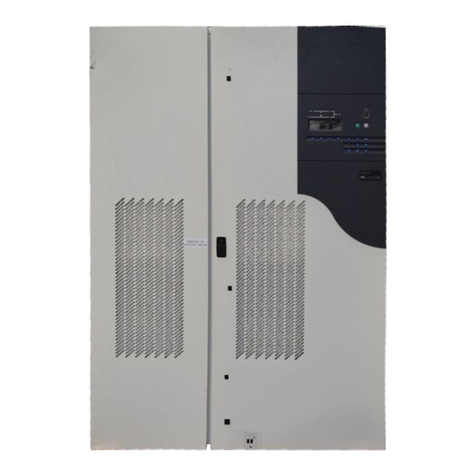
MGE UPS Systems
MGE UPS Systems Galaxy PW User manual
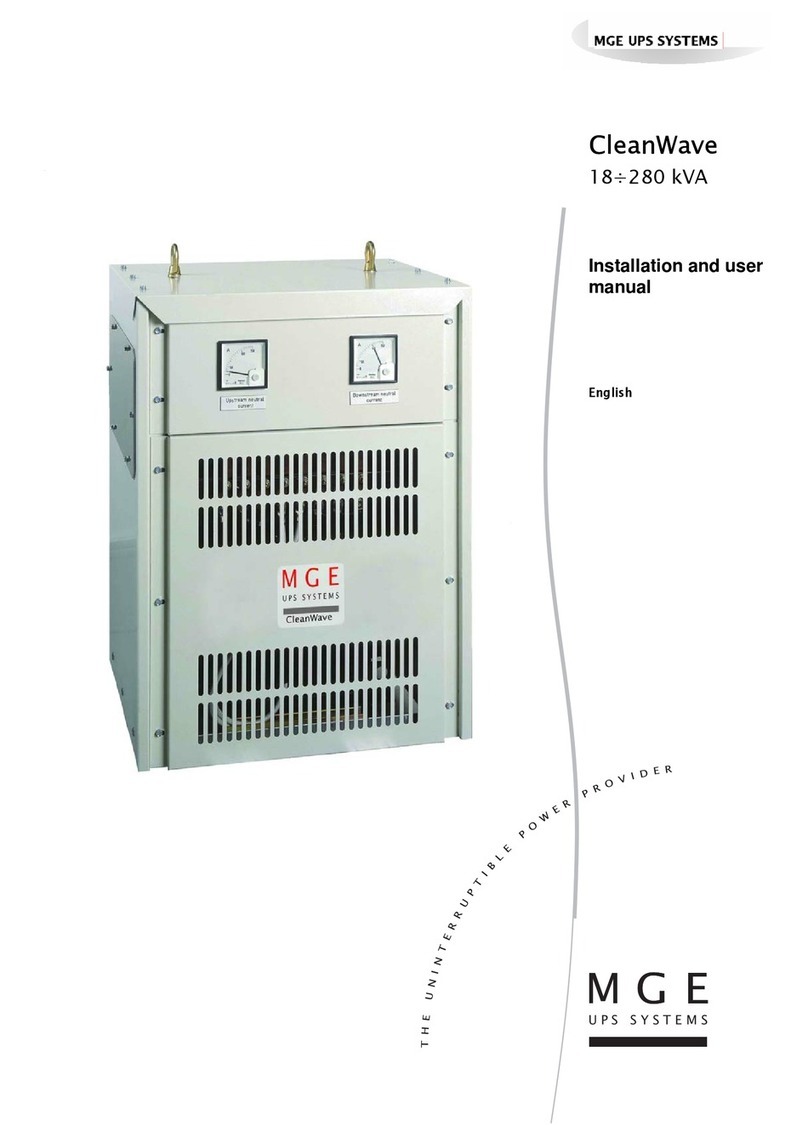
MGE UPS Systems
MGE UPS Systems 18/280 kVA User manual

MGE UPS Systems
MGE UPS Systems 250A User manual
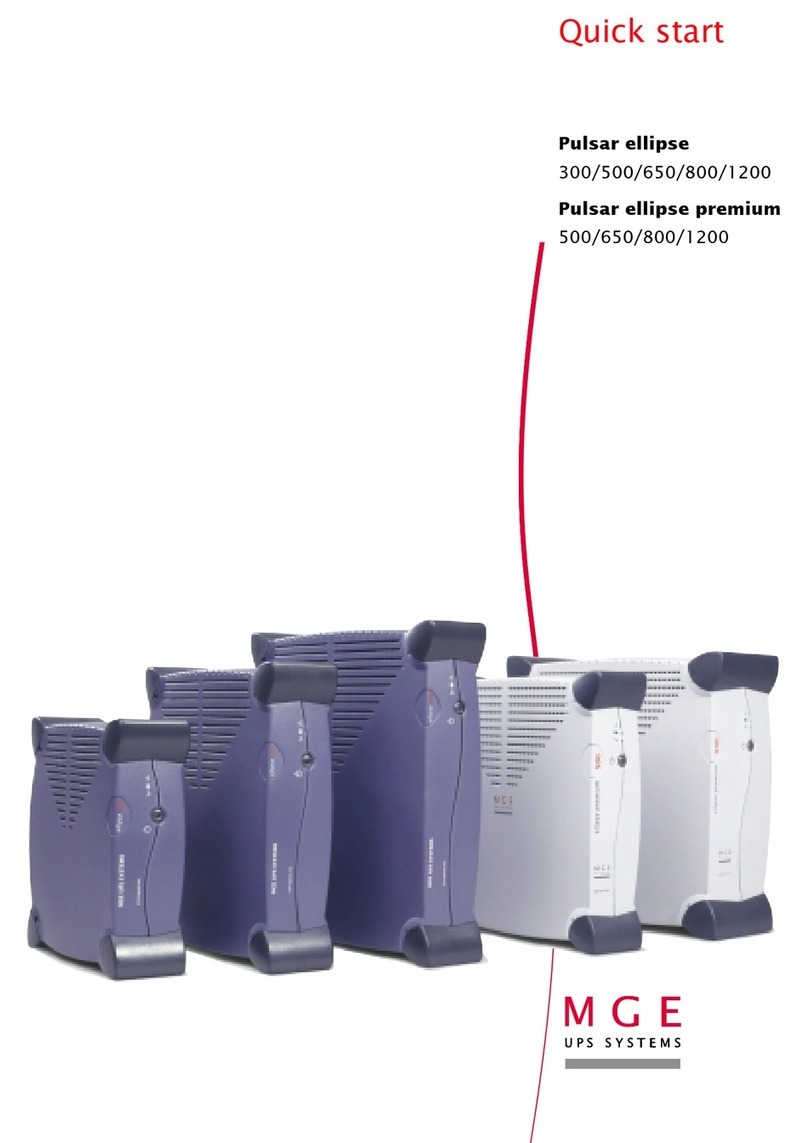
MGE UPS Systems
MGE UPS Systems Pulsar ellipse 300 User manual

MGE UPS Systems
MGE UPS Systems 12280 kVA User manual

MGE UPS Systems
MGE UPS Systems 30A User manual

